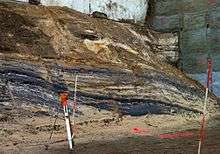Aachen Formation
The Aachen Formation (Dutch: Formatie van Aken; German: Aachen-Formation) is a Cretaceous Period geologic formation in the southern Netherlands and northern Belgium, and adjacent Germany.
| Aachen Formation Stratigraphic range: 85.8 - 70.6 million years | |
|---|---|
 | |
| Type | Geological formation |
| Unit of | Chalk Group |
| Underlies | Vaals Formation |
| Overlies | Limburg Group |
| Lithology | |
| Primary | Sand |
| Location | |
| Region | Southern Netherlands and northern Belgium, and adjacent Germany |
| Type section | |
| Named for | Aachen |
It is part of the Chalk Group and named after the German city of Aachen.
Geography
The formation crops out in southern Belgian and Dutch Limburg and adjacent areas in Germany. The formation can also be found in the subsurface of West-Flanders, where it forms an aquifer from which drinking water is won.
Geology
The Aachen Formation consists of glauconite bearing sand. It was deposited during the Santonian and Campanian ages (85.8 - 70.6 million years ago) of the Cretaceous Period in the Mesozoic Era.
Its base is an unconformity on top of Carboniferous rocks of the Limburg Group, which are more than three times as old. On top of the Aachen Formation is the Vaals Formation, also part of the Chalk Group.
See also
- Cretaceous Europe
- Mesozoic Europe
- List of stratigraphic units in the Netherlands
References